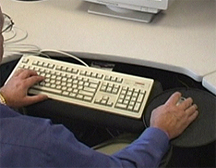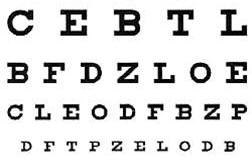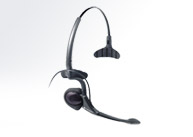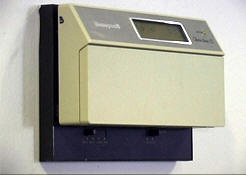Quick Overview - Office Ergonomics |
RelationshipsErgonomics is all about establishing the right relationship between you and your workstation (chair, work surface and equipment). When you set-up and then maintain the correct relationship you will use ergonomics to be more comfortable and productive throughout your day. Here is generally what you want to achieve in your relationship with your workstation: |
ChairSeat height to place your feet firmly on the floor. (Or if chair seat is raised up due to a high worksurface, a footrest to provide foot support.) Seat angle that positions you comfortably in the chair. Seat rocking tension that allows rocking but does not tip back easily. Seat depth that allows for 2 to 3Ē between back of the knee and front of your chair. Back support angle to position you upright when at the keyboard and slightly reclined when not at the keyboard. Back support height to provide lower and mid back support. Armrests that support your forearms with your shoulders relaxed and elbows at your sides.
| 
|
Work surfaceo Adjust your chair seat height to place your feet on the floor and then adjust the worksurface height (i.e. wall panel mounted or keyboard tray) to match your hand position. OR o Adjust your chair seat height to match your hand position with the fixed worksurface height (i.e. stand alone fixed height desk.) NOTE: This may result in your feet not touching the floor and you will need a footrest OR a change of worksurface type. | 
|
Keyboard/Mouseo Elbows at your sides at about 900 with wrists straight and fingers resting on the keys OR o Forearms resting on the worksurface with body pulled up close to worksurface edge, shoulders relaxed, wrists straight and fingers resting on the keys. | 
|
MonitorMonitor positioned directly front of you. (Not at an angle off to the side.) Monitor height so top of monitor screen is at eye level or lower. Monitor distance at least armís length from eye to screen. No glare on your monitor.
| 
|
VisionRegular eye exams are very important. At some point you probably will need reading glasses (bifocals). To properly position your head when reading the monitor make sure you have the monitor at the correct height (low). You may also want to consider computer glasses. Contact you eye doctor.
| 
|
Documentso In-line with you between your monitor and keyboard. o Placed slightly off to the side of the monitor. | 
|
Telephone | 
|
Office equipment | 
|
Lighting Enough overall room light to comfortable see generally in the workstation. (If when you shield your eyes with your hand, you see more comfortably you probably have too much overall light.) Enough task light to comfortably read documents in the workstation. (If you have to bend over to get closer to read hardcopy due to low light levels you probably need more task light.)
| 
|
Environment | 
|
Storage | 
|